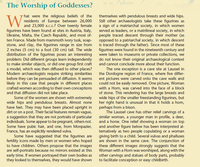Question
How do archaeologists determine if an idea or motif diffused from one place to another or developed independently?

Transcribed Image Text:The Worship of Goddesses?
-hat were the religious beliefs of the
residents of Europe between 26,000
and 23,000 B.C.E.? Over twenty female
figurines have been found at sites in Austria, Italy,
Ukraine, Malta, the Czech Republic, and most of-
ten France. Made from mammoth ivory tusk, soap-
stone, and clay, the figurines range in size from
2 inches (5 cm) to a foot (30 cm) tall. The wide
distribution of the figurines poses an interesting
problem: Did different groups learn independently
to make similar objects, or did one group first craft
a model, which was then diffused to other places?
Modern archaeologists require striking similarities
before they can be persuaded of diffusion. It seems
likely in this case that people in different places
crafted women according to their own conceptions
and that diffusion did not take place.
Some of the women are shown with extremely
wide hips and pendulous breasts. Almost none
have feet. They may have been placed upright in
dirt or on a post. Their facial features remain vague,
a suggestion that they are not portraits of particular
individuals. Some appear to be pregnant, others not.
Some have pubic hair, and one, from Monpazier,
France, has an explicitly rendered vulva.
Some have suggested that the figurines are
fertility icons made by men or women who hoped
to have children. Others propose that the images
are self-portraits because no mirrors existed at this
early time. If women portrayed their own bodies as
they looked to themselves, they would have shown
themselves with pendulous breasts and wide hips.
Still other archaeologists take these figurines as
a sign of a matriarchal society, in which women
served as leaders, or a matrilineal society, in which
people traced descent through their mother (as
opposed to a patriarchal society, in which descent
is traced through the father). Šince most of these
figurines were found in the nineteenth century and
were taken to museums or private collections, we
do not know their original archaeological context
and cannot conclude more about their function.
The one exception is a cave site at Laussel in
the Dordogne region of France, where five differ-
ent pictures were carved onto the cave walls and
could not be easily removed. One picture, Woman
with a Horn, was carved into the face of a block
of stone. This rendering has the large breasts and
wide hips of the smaller freestanding figurines, but
her right hand is unusual in that it holds a horn,
perhaps from a bison.
The Laussel cave has other relief carvings of a
similar woman, a younger man in profile, a deer,
and a horse. One relief showing a woman on top
and another figure below has been interpreted al-
ternatively as two people copulating or a woman
giving birth to a child. Several vulvas and phalluses
are shown in the same cave. The conjunction of
these different images strongly suggests that the
Woman with a Horn was worshiped, along with the
other carvings and statues of body parts, probably
to facilitate conception or easy childbirth.
Expert Solution
This question has been solved!
Explore an expertly crafted, step-by-step solution for a thorough understanding of key concepts.
This is a popular solution
Trending nowThis is a popular solution!
Step by stepSolved in 3 steps
